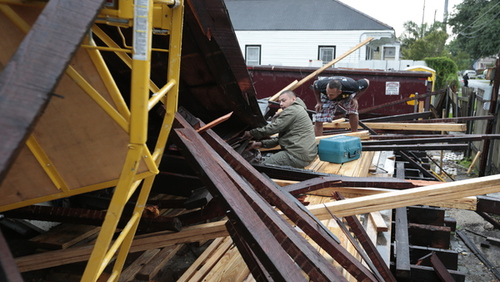
According to the Federal Emergency Management Association (FEMA), May is National Building Safety Month. It’s especially timely as many in the Midwest and southern Plains face the task of rebuilding homes and property damaged by tornadoes and severe storms. For property owners in hurricane-prone areas, having a building that can withstand strong winds is critical.
Engineers and architects who design high-rise buildings factor in the wind load, which can give you the sensation that the building is swaying in a high wind, especially if you’re on the upper floors. Some high-rises stagger elevator banks to account for wind sway as well. Although you may not be putting up a high rise, you should take wind load into account too.
The International Building Code Council and Simpson Strong-Tie Company Inc. offer these five steps to help ensure that your home won’t be blown away.
1. Wise up on wind.
Knowing how high winds work will help you make your home safer and more secure. There are four ways wind can affect your home:
- Uplift. Wind flows over the roof of your home creating a lifting effect.
- Racking. Wind exerts horizontal pressure that can cause your home to tilt.
- Sliding. Wind exerts horizontal pressure that can cause your home to slide off its foundation.
- Overturning. When your home is unable to rack or slide, wind can cause the walls to rotate off the foundation.
2. Create a path.
You need a continuous load path—that is, a method of construction that ties your house together from the roof to the foundation, using a system of framing materials, metal connectors, fasteners (like nails and screws) and reinforced walls called shearwalls.
If your home is built with a continuous path, it will be better equipped to resist the forces of high winds by redistributing the pressure of the wind from the exterior of your house to the frame and then to the foundation.
Your architect or building engineer should take a continuous path into account when designing your home, but be sure to ask about it. If possible, have the architect or contractor show you the path on the blueprints so you understand how it works.
3. Crack the code.
Check with your municipal or state building department to determine whether you live in a high-wind speed zone. Building standards are much stricter for areas susceptible to high winds.
If you’re remodeling, ask about the building code currently in effect and confirm that your builder and architect have considered updated codes. For example, in some neighborhoods, remodeled homes have to meet different standards than new construction. You also may have height restrictions based on susceptibility to high winds.
You should also speak with your broker or homeowner’s insurance carrier while the building is being designed. The broker or carrier will be able to give you information on good building practices for your geographic area. They may even have tips that will help reduce your premiums while strengthening your building.
In Texas, you can contact the Texas Windstorm Insurance Association for tips on building and access to insurance information. Other states might have similar information available so check with your state department of insurance as well.
4. Know your builder.
Check your builder’s reputation and experience with building in a high-wind area. A reliable building contractor will use metal connectors to create a continuous load path, and your blueprints or building specifications should require them.
Get references, especially from other property owners who have had wind-resistant homes built by the same contractor. You want to know what their experience with wind storms has been.
Ask the builder, architect or structural engineer about ways to make your home more wind resistant. The structural engineer or qualified, licensed home inspector can identify areas that may need to be retrofitted.
Ideally, you and your contractor will become good friends during the remodeling process. A good relationship is critical to the success of the project. You’ll be more comfortable asking questions, and the contractor will provide better service. (That’s been my experience.)
5. Get involved, stay involved.
The best way to ensure that your home is built correctly is to be part of the building process from beginning to end. Visit the job site often, particularly when the house is being framed.
You should ask questions about the kind and quality of materials being used and take lots of pictures—ideally every day. This allows you not only to track the progress of the job but also to confirm what materials were used at each stage—something that you can’t do easily after the drywall is up.
At Prime Insurance Agency, we can work with you to make sure you've got the coverage you need, while at the same time using all possible credits and discounts to make that coverage affordable.
Call us at 732-886-5751 or send us a note at PRIME [at] primeins [dot] com. We want to help you meet your goals, and make sure what's important to you is protected!


Discussion
There are no comments yet.